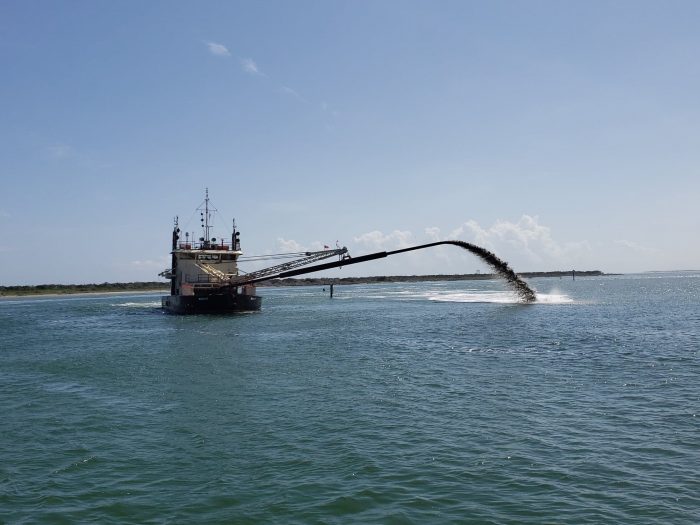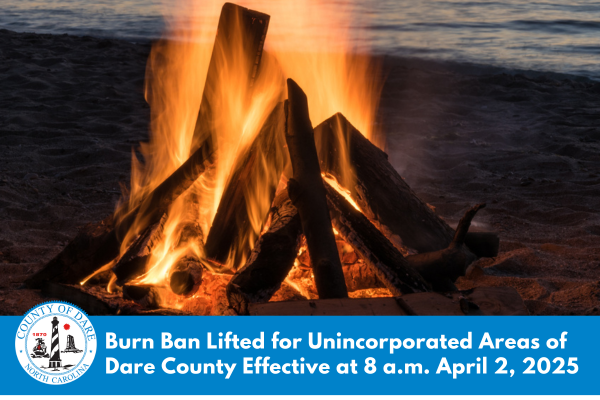Waterways Commission navigates new hurdles to schedule fall dredging in Hatteras Inlet

Absent emergency measures, bureaucratic snares could yet again hinder navigational safety in Hatteras Inlet, leaving members of the Dare County Waterways Commission worried about a lackluster fall fishing season because of poor channel conditions.
At its first in-person meeting since the Coronavirus pandemic began in March 2020, held Monday evening at the county Administrative Building in Manteo, commissioners reacted with bitter sarcasm, sharp criticism, or stunned silence at news of the latest delays in securing important approvals to maintain channels.
“This is why people get mad,” said commissioner KP Scott, reacting to news that the application for a minor permit modification to dredge a section of the Connector Channel now requires a more time-consuming major permit modification.
Scott, who runs the Miss Hatteras headboat, added that a 2- or 3-day dredging project shouldn’t be so difficult.
“This is just a failure,” he said. “Everybody in Hatteras is just going to be up in arms about that.”
Speaking remotely, Ken Willson, Dare County dredge projects consultant with Coastal Planning & Engineering of North Carolina, explained that the amount of acreage in the proposed project was in excess to what would qualify for a minor permit, triggering the upgraded requirement for a major permit from the state.
In a later interview, Barton Grover, commission administrator, said that the original application was submitted in early to mid-August, and expected to be approved by mid-September. The environmental window to dredge is October 1 through March 31, and any projects outside that period require a special permit.
Maintenance of the Connector Channel is complicated by the fact that a section of the channel between Buoy 8 and Buoy 9 is outside of the dredge window that is permitted under a Memorandum of Approval (MOA) between the Corps and Dare County that allows the county and state to pay the Corps to dredge the non-federal channel. (To add to the head-spinning nature of the inlet issues, the channel is sometimes also referred to as the Connecting Channel, the South Ferry Channel corridor extension, and the former South Ferry Channel.)
Since the state had granted a temporary permit to clear shoals 500 feet outside the approved corridor back in the spring, Willson said, it’s likely it won’t need the full 75 days to complete the application process. The expectation is that the permit will be “in-hand” by the second half of October, he added.
But commission chairman Steve “Creature” Coulter said that he was concerned that the minor shoaling that boaters are seeing now in the channel could quickly become a dredging challenge and even a danger.
“If we stop by and do some maintenance dredging, we can keep this thing open,” he said, adding: “We need to get in there when [the Corps dredge] heads south, or we’re not going to be able to dredge when the window opens up.”
Willson said that it might be possible for the Corps to come in earlier, if the county makes a special urgent request to the state. The county has transferred $195,000 of its available non-federal matching funds to the Corps. The Corps’ dredge plans to leave Oregon Inlet in early October and head to the Holden Beach area.
In the discussion that followed, the commission agreed to ask permission for the Corps’ dredge to stop in Hatteras earlier, based on its expected availability.
“Everybody is really familiar with this thing,” Willson told commissioners, referring to the Connector Channel project. “We just have to make the call.”
Meanwhile, Todd Horton, deputy chief of navigation with the Corps’ Wilmington District, also attending remotely, told commissioners that approval of the long-anticipated Rollinson Channel realignment has also been delayed about a month by questions from one of the environmental agencies involved in permitting. The environmental assessment is now expected to be finalized by Oct. 24, he said.
The realignment of the channel will allow the Corps and its contractors to have much more flexibility to dredge when- and where-needed in Hatteras Inlet.
“As soon as that is approved,” Horton said, “we’ll have [that] authority.”
But the timing of approval of the much-delayed realignment has the potential to throw another wrench in dredging the Connector Channel. As Grover explained after the meeting, the realignment — which had been expected to be finalized by Oct. 7 — would encompass the Connector Channel, eliminating the need for other permits. But if for some reason the realignment was delayed again, he said, the current 1-year MOA that is due to expire in February would not yet be renewed, leaving the county with no permit to maintain that channel.
Faced with that possibility, the commission agreed to start the renewal process in time to have the complete MOA completed before it expired just in case it is necessary.
Yes, the county needs to hedge its bets and hold course for an October 2023 approval, a clearly perturbed Coulter told commissioners.
“Everybody in this room knows the realignment was going to happen last October,” he said sarcastically.
Still, life could brighten considerably for the commission once it is finalized.
For now, the non-federal Sloop Channel, which is part of the current Hatteras-Ocracoke ferry route, is maintained under the South Ferry Channel MOA, but it also would be included under the realigned Rollinson Channel project. Once it’s completed, maintenance of the inlet channels would be authorized under the current coast-wide MOA that covers all the state’s federally-authorized inlet channels. That MOA does not expire until Sept. 30, 2026.
Grover said with the realignment, it should be much easier to avoid the seeming unending crises with shoaling and beating the clock permitting dredge projects, since the Corps will have more freedom to address Hatteras Inlet channels. Also, the county will have its own new dredge, the Miss Katie, available to schedule regular maintenance.
But for the immediate concerns with the Connector Channel, Grover said, he is optimistic that the state will take the project history into account when considering the situation.
“It’s getting shallower,” he said of the channel, with some spots just 5 or 6 feet deep. “Once the [Corps dredge] gets it to 8 feet, we’ll schedule the Miss Katie to follow up while it’s still deep and do another one-week [dredging] event that fall so it holds up through the winter.”
And the state is familiar with the current dilemma for watermen and charter boats who need safe passage in and out of the inlet for their livelihoods, and the need to quickly address the shoaling.
“Hopefully, they’re comfortable with our request to do it again,” Grover said.
Commissioners Danny Couch, Michael Flynn, Natalie Kavanaugh, Kermit Skinner, and Ernie Foster were also in attendance. The next meeting is scheduled for Oct. 11 at 7 pm in Buxton.













